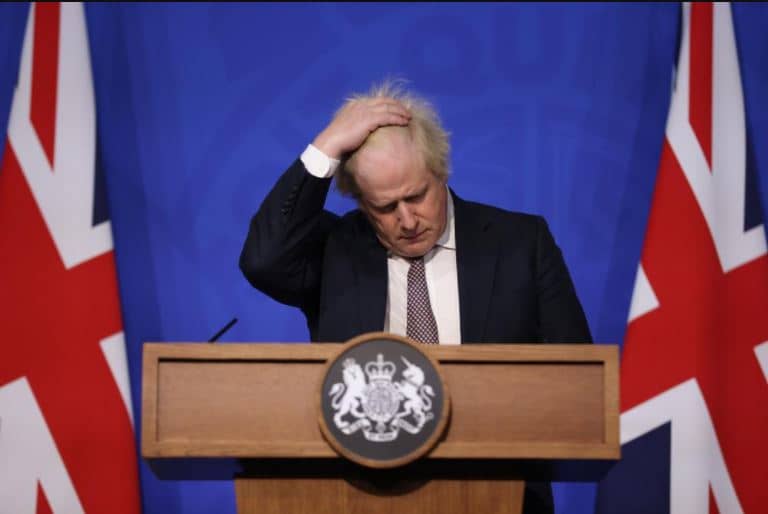
DAILY MAIL: Did official figures overestimate Britain’s grim Covid death toll?
It’s a question that has been asked persistently by medics and members of the public alike almost since the start of the pandemic.
First, disturbing stories emerged from bereaved relatives of terminally ill patients who died from the disease they’d battled, only to be posthumously labelled Covid victims.
Then health chiefs admitted, embarrassingly, that the numbers they’d been feeding the Government were only an approximation – provoking fury from Ministers.
More recently it was revealed that a quarter of Omicron deaths included in the daily figures did not, in fact, list Covid as a primary cause.
More than two years since Covid-19 emerged, many feel they want a simple answer: how many were killed by this virus?
Last week, in the first of a series of special reports probing the science that has underpinned our pandemic response, The Mail on Sunday set about tackling the ongoing concerns that tests used to diagnose Covid were picking up people who were not actually infected.
The conclusion of some scientists was, yes, they did. And there were those who maintained that despite shortcomings, PCR swabs – used by millions – were accurate enough.
Yet one study suggested that as many as a third of all positive cases may not have been infectious at the time they took the test.
It not only means the true scale of the pandemic could have been distorted, but also that many people may have been forced to self-isolate unnecessarily.
Equally concerning is the idea that the UK’s stark and terrifying death figures – which were broadcast daily – were misleading and even overblown.
And today we will try to uncover the truth, or get as close as we can.
Another step forward in understanding comes from new analysis from scientists at the University of Oxford and charity Collateral Global, shared exclusively with this newspaper.
The group combed through 800 responses to Freedom of Information requests made by members of the public to medical institutions such as care homes and hospital trusts, and found fundamental flaws in way Covid fatalities were recorded.
In total, 14 different terms were used to describe a person who had died with Covid – including ‘underlying Covid’, ‘due to Covid’, ‘involving Covid’ and ‘died within either 28 or 60 days of a positive test’.
Some hospital trusts required a positive test to certify a Covid death, while others didn’t.
Most shockingly, in care homes, deaths were certified by doctors making their inspection via a video call – and this was permitted due to emergency guidance introduced in April 2020.
The experts say this, coupled with the lack of testing in care homes, means it is likely that assumptions were made and Covid was wrongly attributed as the cause of death.
Does this mean the Covid death figure is an over-count? There is no way of knowing for certain – which the Oxford group suggests is far from ideal.
‘It is incredibly important to understand the logical chain of events that led to death,’ says Professor Carl Heneghan, epidemiologist and director of the University of Oxford’s Centre for Evidence-Based Medicine, and an author of the new report.
‘But if every health body is using a different definition, how do we know whether Covid has directly caused the death or if it was something else that was underlying?
‘Two years into this pandemic, it is clear nobody can really understand or answer that question.’
UConcerns about Covid death figures first emerged in mid-2020 after it was revealed that the now-defunct Public Health England calculated its rolling toll simply by checking NHS databases to see if a person who had tested Covid positive at some point had died.
It did not consider how long before the death that a test result occurred.
A Government source admitted at the time: ‘You could have tested positive in February, have no symptoms, then be hit by a bus in July and you’d be recorded as a Covid death.’
In August that year, Covid testing chief, Professor John Newton, insisted the method was robust but added: ‘It is only an approximation of the number of people who die from Covid-19, because other causes of death are included and some people who die from Covid-19 never had a positive test.’
Shortly after this, then Health Secretary Matt Hancock announced the closure of Public Health England, to be replaced by the UK Health Security Agency – where Prof Newton is a director. The protocol was also changed, so that deaths only within 28 days of a positive Covid test were counted.
The Government also began reporting a second figure – one that experts claimed was more trustworthy – compiled by the Office for National Statistics and based on whether Covid was written on a patient’s death certificate.
But worries began to emerge about the accuracy of this, too. Death certificates routinely list both the direct causes of death – the specific condition that killed that person, such as pneumonia or sepsis, and what led to that fatal condition or event developing, such as a viral infection.
They may also list other conditions that might have contributed to that person dying – for instance, if they suffered a long-term lung illness, or diabetes, that made the patient vulnerable.
These details are key, as it was long known that frailty and pre-existing conditions made people far more likely to die of Covid. The worry was that those who died due to long-term health problems, but happened to pick up Covid along the way, were being counted in the official statistics. This would be a distortion of the truth.
In early 2021, audits by the Office for National Statistics showed that roughly 90 per cent of the Covid deaths it reported had died directly from the disease – meaning Covid was listed as a primary cause on their death certificates, not simply a contributory factor.
But the Collateral Global report has now cast doubt over even this data. It uncovered more than 1,500 cases, across eight UK hospitals, where Covid was the only thing listed on the death certificate.
Epidemiologist Professor Tom Jefferson, a co-author of the paper, describes this as ‘implausible’.
It is well known that Covid deaths were vastly more likely in those with underlying conditions, such as heart disease or dementia, and so he adds: ‘It means we can’t trust what is written on that certificate.’
Lack of tests in the first wave of the pandemic may have compounded problems. A study by researchers at the University of Edinburgh, involving 80,000 Covid patients admitted to 247 UK hospitals between March and August 2020, found that in nearly a third of cases, no confirmatory PCR test was carried out.
Perhaps most concerning is the way in which deaths were routinely recorded in care homes, where 45,632 Covid fatalities occurred.
At the beginning of the pandemic the Government issued emergency guidance that allowed doctors to verify a death remotely – via a video call or webcam.
This meant that care home staff would make the calls and hold the camera up so the doctor could see the deceased.
The doctor could write the death certificate based on this.
Remote death certification policies have remained in place, but are set to be scrapped on Thursday along with the rest of the temporary coronavirus legislation.
Prof Jefferson suspects this meant that assumptions were made, resulting in significant errors.
The Oxford researchers’ report found that in some care homes, half of all Covid deaths involved an incomplete death certificate, where only Covid was listed.
Prof Heneghan adds: ‘By the very nature of people who are in care homes, they have lots of co-morbidities [the presence of two or more diseases at the same time] that contribute to their death.
‘This usually includes either underlying heart failure, or diabetes or something else – and then they got Covid.
‘So there should be more than one issue besides Covid on the death certificate, otherwise we don’t know why these people died.’
Experts say these factors mean the true toll of Britain’s care home deaths remain a mystery.
Prof Heneghan says: ‘Nobody was checking any of these deaths properly. You could just put Covid on the certificate and no one asked questions about it.’
The researchers say there is a possibility this means death counts have been an overestimation – but the opposite could also be true.
‘We’re not trying to say one way or the other, but the key is accuracy,’ says Prof Heneghan. ‘Was Covid really the predominant underlying case of death in care homes – or was it something else?’
Other experts are less sceptical, however. ‘Certainly for all the Covid deaths I witnessed, there was no doubt what they died from,’ says Dr Sue Crossland, an acute medicine doctor in an NHS hospital in the North of England.
Another sign that the Covid death figures aren’t an overestimate comes from looking at total numbers of excess deaths.
These numbers are the total of people who die of all causes on top of what is expected in an average year. Between March and May 2020 there were roughly 55,000 excess deaths in the UK, and 63,000 in the winter of 2020.
The winter figures are six times higher than the same period in 2019.
In 2017, during a bad flu season, excess deaths were the highest in more than 30 years – 50,000. But some say excess deaths can be explained by lockdown-related causes rather than Covid itself.
Research by the British Heart Foundation found that at least 5,000 heart-attack patients had gone without life-saving treatment between March and July 2020.
‘Some of the excess deaths will be people who missed out on care,’ says Prof McConway, emeritus professor of Applied Statistics at the Open University.
‘But the majority of excess deaths are clumped together in April and May. And most of the lockdown-related deaths, including people missing out on cancer treatment, wouldn’t have been so immediate.’
Prof Heneghan suggests that only a forensic analysis of historical Covid deaths will uncover the truth. He adds: ‘We should take a sample of deaths that had Covid written on the certificate and try to validate the accuracy.
‘Get all the medical documentation and expert consultants to look at it independently. Then we will understand the correct chain of events that led to a person’s death – and if it matches up to what is on the death certificate.’
Advertise with the mоѕt vіѕіtеd nеwѕ ѕіtе іn Antigua!
We offer fully customizable and flexible digital marketing packages.
Contact us at [email protected]

















A more appropriate question is how many were killed by the treatments they received for covid. The lack of early treatments with cheap, safe and effective off label repurposed drugs could have prevented 80% of covid deaths. Then came the deaths caused by being placed on ventilators, without the presentation of fatigue, based solely on low O2 sats. Then the remdesivir induced renal failure leading to flash pulmonary edema deaths. The EARLY failure to recognize that covid was an inflammatory, thrombotic disease that required anticoagulants/anti inflammatory drugs. That it was an organizing pneumonia an not ARDS. That the steroids doses used were too low, that giving methylprednisolone instead of dexamethasone for severe covid was better. That giving antivirals after the viral replication phase was useless. And the list goes on and on.
The WEF’s October 2019 simulation of Event 201 CV pandemic projected a death toll of 65 million.
I guess we got lucky….FOR NOW!!
Comments are closed.